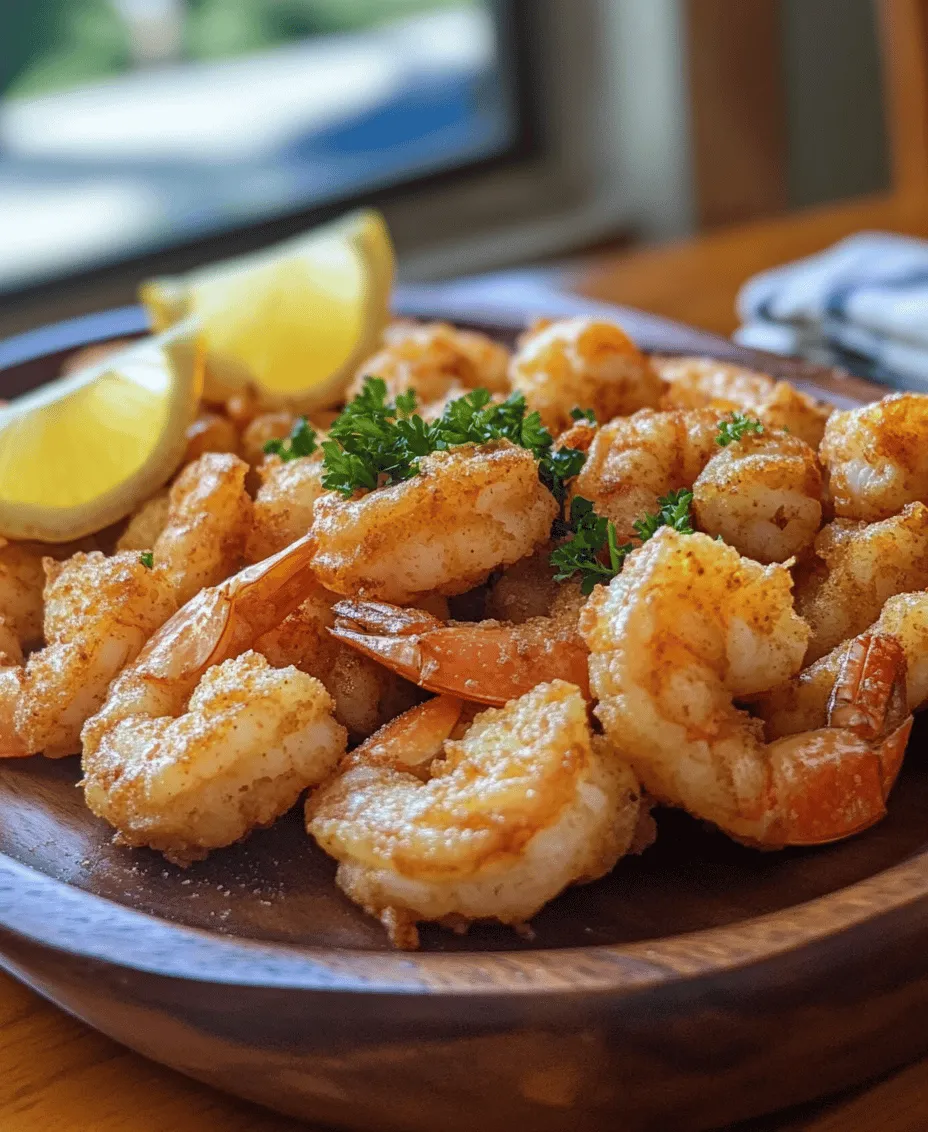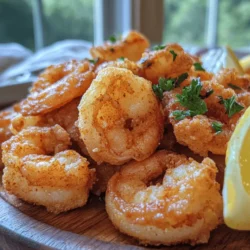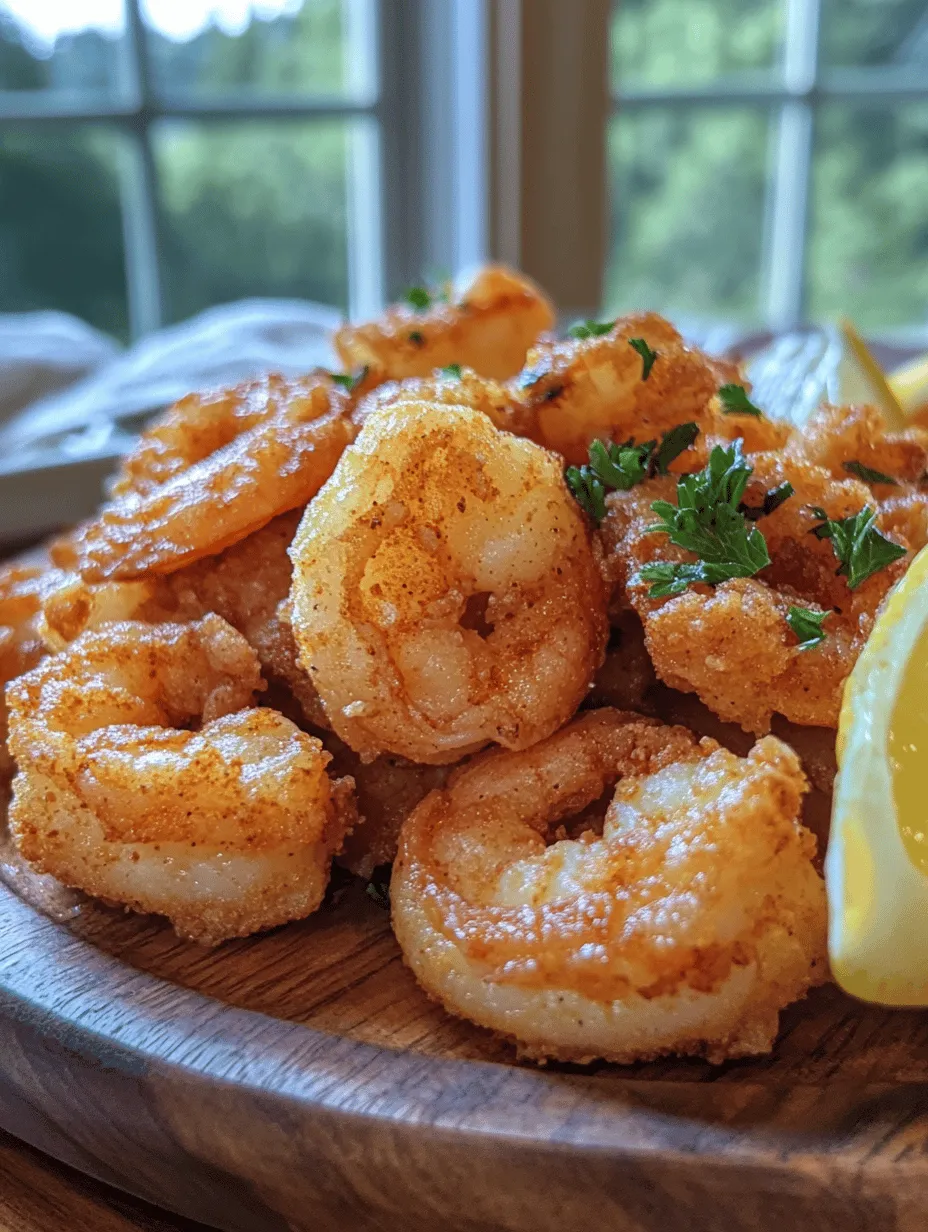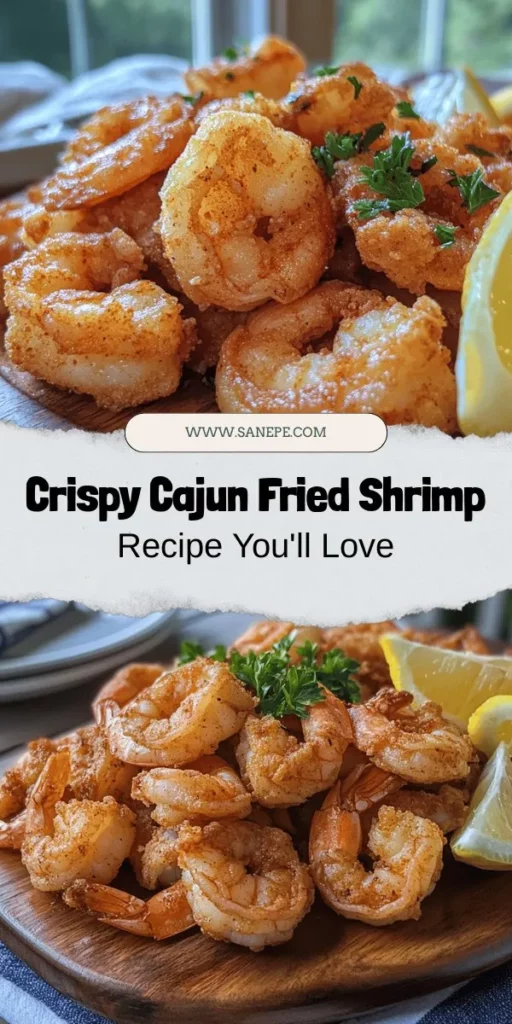Introduction
Cajun cuisine is a vibrant tapestry of flavors and traditions, deeply rooted in the rich cultural history of Louisiana. Originating from the Acadian people who settled in the bayous of the southern United States, Cajun food is characterized by its bold spices, hearty ingredients, and a spirit of creativity and improvisation. Among the many dishes that exemplify this culinary art, Cajun Fried Shrimp stands out as a beloved classic, adored by locals and visitors alike.
This dish captures the essence of Cajun cooking, combining succulent shrimp with a blend of spices that create an irresistible burst of flavor. The crispy coating adds texture, making each bite a delightful experience. What makes this dish even more special is the ability to create it at home, allowing you to enjoy the authentic taste of Louisiana in your own kitchen. Using fresh, high-quality ingredients is paramount to achieving the best results, as they not only enhance the flavor but also elevate the overall dining experience.
In this article, we will delve into the world of Cajun Fried Shrimp, exploring its culinary roots, examining the essential ingredients, and guiding you through the initial steps of preparing this mouthwatering dish.
Understanding Cajun Cuisine
Cajun cuisine is more than just food; it is a reflection of the history, culture, and lifestyle of the people of Louisiana. The roots of Cajun cooking can be traced back to the Acadians, who were exiled from Canada in the 18th century. They settled in the swamps and bayous of Louisiana, where they adapted their cooking techniques to use the local ingredients available to them. This adaptability is a hallmark of Cajun cuisine, which often emphasizes using whatever is on hand to create hearty, flavorful meals.
Key characteristics of Cajun food include its robust flavors, the use of spices, and traditional cooking techniques. Cajun dishes often feature a “holy trinity” of vegetables: onions, bell peppers, and celery, which form the base for many recipes. Spices such as paprika, cayenne pepper, and garlic powder are commonly used to impart a signature heat and richness to the dishes.
Cajun Fried Shrimp fits beautifully into this culinary landscape, embodying the spirit of Cajun cooking. The dish showcases the use of fresh seafood, which is abundant in the Gulf region, and highlights the importance of flavoring techniques such as marinating and seasoning. The result is a dish that is not only delicious but also steeped in tradition and cultural significance.
Ingredients Breakdown
To create the ultimate Cajun Fried Shrimp, it is essential to understand the ingredients that make this dish come alive. Each component plays a vital role in achieving the perfect balance of flavor and texture.
Large Shrimp
When it comes to fried shrimp, size matters. Opt for large, fresh shrimp, ideally wild-caught from the Gulf of Mexico. These shrimp provide a meaty texture and a sweet flavor that pairs beautifully with the spices used in the dish. Freshness is key—look for shrimp that have a mild ocean scent and a firm texture. Avoid shrimp that have a strong fishy odor, as this indicates they may not be fresh.
Buttermilk
Buttermilk is a crucial ingredient in this recipe, serving as a marinade for the shrimp. The acidity of buttermilk helps to tenderize the shrimp while infusing them with flavor. Additionally, it creates a creamy coating that allows the dry ingredients to adhere better, resulting in a crispier texture. For optimal results, allow the shrimp to marinate in buttermilk for at least 30 minutes, though longer marination (up to 2 hours) can yield even more flavorful shrimp.
Hot Sauce
Cajun cuisine is known for its heat, and hot sauce is an essential element in this recipe. The choice of hot sauce can be customized based on your personal heat preference. A few dashes of your favorite hot sauce mixed into the buttermilk will elevate the flavor profile and add a delightful kick. For those who prefer a milder dish, you can reduce the amount of hot sauce or choose a milder variety.
Flour and Cornmeal
The perfect coating for Cajun Fried Shrimp is achieved through a combination of all-purpose flour and cornmeal. The flour provides structure, while the cornmeal adds a delightful crunch. Mixing these two ingredients in the right proportions will yield a coating that is both crispy and flavorful. Aim for a ratio of approximately two parts flour to one part cornmeal for the best results.
Cajun Seasoning
Cajun seasoning is the heart and soul of this dish, providing the signature flavor profile that defines Cajun cooking. A mix of spices, including paprika, cayenne pepper, onion powder, garlic powder, and dried herbs, creates a robust and aromatic blend. You can either purchase a pre-made Cajun seasoning mix or create your own at home, allowing you to adjust the spice levels to suit your palate. For those who enjoy a bit more heat, additional cayenne pepper or black pepper can be added to the seasoning blend.
Optional Ingredients
For those who love to experiment with flavors, consider adding black pepper or cayenne pepper for an extra kick. These ingredients can be adjusted based on your spice tolerance and personal preferences. Remember, the beauty of Cajun cooking lies in its versatility, so don’t hesitate to make this recipe your own.
Quality ingredients are paramount in achieving the authentic flavors of Cajun Fried Shrimp. Whenever possible, source fresh, local ingredients to ensure the best taste. The combination of high-quality shrimp, flavorful seasonings, and a well-balanced coating will take your Cajun Fried Shrimp to new heights.
Step-by-Step Cooking Instructions
Preparation of the Shrimp
Before frying, the first step is to prepare the shrimp adequately. Begin by peeling and deveining the shrimp, leaving the tails intact for added presentation and ease of eating. Rinse the shrimp under cold water to remove any residual grit or impurities. Pat them dry with paper towels, as excess moisture can prevent the coating from adhering properly.
Once the shrimp are clean and dry, it’s time to marinate them in buttermilk. Pour the buttermilk into a bowl, and add a few dashes of hot sauce to infuse the shrimp with flavor. Stir well to combine. Place the shrimp in the buttermilk mixture, ensuring they are fully submerged. Cover the bowl with plastic wrap and refrigerate for at least 30 minutes, allowing the flavors to penetrate the shrimp. For optimal results, marinate for up to two hours—this step is crucial for ensuring tender, flavorful shrimp.
Creating the Coating
While the shrimp are marinating, it’s time to prepare the coating. In a large mixing bowl, combine the all-purpose flour, cornmeal, and Cajun seasoning. Use a whisk to thoroughly mix the dry ingredients, ensuring that the seasoning is evenly distributed throughout the mixture. This step is essential for achieving a uniform flavor in every bite.
Once the dry ingredients are well combined, remove the shrimp from the refrigerator. Take each shrimp out of the buttermilk and allow any excess liquid to drip off. Dredge the shrimp in the flour and cornmeal mixture, pressing gently to ensure an even coating. Shake off any excess coating before placing the shrimp on a baking sheet lined with parchment paper. This step will help prevent the shrimp from sticking together and will make frying easier.
As you coat the shrimp, you may need to replenish the flour and cornmeal mixture, depending on the number of shrimp you are preparing. Be sure to keep the coating mixture well-mixed to maintain an even distribution of spices.
Once all the shrimp are coated, let them sit for a few minutes to allow the coating to set. This will help create a crispier texture when fried.
With all the preparations complete, you are now ready to fry the shrimp to perfection, creating a dish that is sure to impress your family and friends with its authentic Cajun flavor and delightful crunch.

Perfecting the Frying Process
Frying shrimp to perfection is an art that requires attention to detail, especially when preparing Cajun Fried Shrimp. The first critical aspect to consider is the oil temperature. Maintaining the right temperature, typically around 350°F to 375°F, is essential for achieving that golden crispy exterior while ensuring the shrimp cooks evenly. If the oil is too cold, the shrimp will absorb more oil, resulting in a greasy texture rather than a crispy finish. Conversely, if the oil is too hot, the exterior may burn before the insides are fully cooked.
To ensure optimal frying conditions, use a thermometer to monitor oil temperature closely. Preheat your oil in a deep pot or a deep fryer. Once the oil has reached the desired temperature, you can start frying your shrimp in batches. This leads us to the next crucial technique: avoiding overcrowding.
When shrimp are overcrowded in the frying pot, they lower the oil temperature, which can lead to uneven cooking. Instead of throwing all the shrimp in at once, fry them in small batches. This allows the oil to maintain a consistent temperature and ensures each shrimp gets the attention it deserves. As a guideline, aim to fry no more than 6 to 8 shrimp at a time, depending on their size and the pot’s capacity.
As you fry, keep an eye out for visual cues to determine doneness. Perfectly cooked shrimp will turn a vibrant pink color, and the exterior will be crispy. Each shrimp should curl into a C-shape, signaling that it’s cooked through without being overdone. Depending on the size of your shrimp, this process usually takes about 3 to 4 minutes per batch. Once cooked, remove the shrimp using a slotted spoon and drain them on a plate lined with paper towels to absorb any excess oil.
Serving Suggestions
Presentation is key when serving your Cajun Fried Shrimp. To create an appealing dish, arrange the shrimp on a large platter with a sprinkle of fresh parsley for a pop of color. You can serve the shrimp alongside a homemade remoulade or cocktail sauce for dipping. Consider using a squeeze of fresh lemon juice over the top just before serving to enhance the flavors and add brightness to the dish.
When it comes to side dishes that complement Cajun Fried Shrimp, there are numerous options. Classic accompaniments include coleslaw, which adds a refreshing crunch, or a side of Cajun dirty rice for a hearty pairing. Alternatively, consider cornbread for a Southern touch, or a garden salad with a tangy vinaigrette to balance the richness of the shrimp.
Don’t overlook the importance of garnishes! Fresh herbs, like parsley or cilantro, can elevate your dish. Citrus garnishes, such as lemon or lime wedges, not only add a zesty flair but also offer a refreshing contrast to the spices in the shrimp.
Nutritional Information
Cajun Fried Shrimp is a delightful indulgence, but understanding its nutritional aspects can help you integrate it into a balanced meal. Shrimp is a lean source of protein, low in calories, and rich in essential vitamins and minerals, including B12, iodine, and selenium. A typical serving of Cajun Fried Shrimp can range from 200 to 300 calories, depending on the amount of breading and frying oil used.
Portion control is crucial when enjoying this dish, particularly if you’re also serving rich sides. A good serving size is about 4 to 6 ounces of shrimp, which allows you to enjoy the flavors without overindulging. Pairing your shrimp with light sides, like salads or steamed vegetables, can create a more balanced meal.
For those with dietary restrictions, Cajun Fried Shrimp can be made gluten-free by using gluten-free breadcrumbs or alternative breading options like cornmeal. This ensures that everyone can enjoy this flavorful dish without compromising on taste.
Culinary Variations
While the classic Cajun Fried Shrimp recipe is already a treat, there are several ways to customize it to suit your palate or dietary preferences. For spice lovers, consider incorporating different hot sauces into the breading mixture or using spicier Cajun seasonings to amp up the heat. This could include adding cayenne pepper or using a fiery hot sauce in the marinade.
You can also experiment with different seafood options or proteins. Try substituting shrimp with fish fillets, like catfish or tilapia, which can also be fried to crispy perfection. Alternatively, for a unique twist, consider using chicken tenders or even tofu for a vegetarian version.
For those looking to embrace plant-based cooking, try creating a vegetable-based version of the dish. Slice zucchini, eggplant, or bell peppers into thick strips and coat them with the same Cajun breading before frying. Not only does this provide a delicious alternative, but it also brings a delightful crunch to your plate.
Cultural Significance and History
Cajun cooking, with its roots in the French Acadian culture, has evolved into a rich tapestry of flavors and traditions over the centuries. Originally, Cajun cuisine drew influence from French, Spanish, African, and Native American cooking, reflecting the diverse community of southern Louisiana. The preparation of seafood, especially shrimp, plays a significant role in this culinary landscape, with dishes often made to celebrate family gatherings, festivals, and regional celebrations.
Cajun Fried Shrimp has become a staple not only in home kitchens but also in restaurants across the country. It embodies the spirit of Cajun cooking—bold flavors, hearty portions, and a communal dining experience. Anecdotes of family recipes passed down through generations often involve these fried shrimp, symbolizing both tradition and creativity in the kitchen.
Whether enjoyed during Mardi Gras festivities or a casual family dinner, Cajun Fried Shrimp continues to bring people together. Each bite of this crispy, flavor-packed dish tells a story of heritage, regional pride, and the joy of sharing good food with loved ones.
Conclusion
As we recap our journey through creating the Ultimate Cajun Fried Shrimp Delight, it’s clear that this dish is more than just a meal; it’s a celebration of culture and flavor. From perfecting the frying process to experimenting with delicious variations, each step invites you to embrace the joy of cooking.
We encourage you to dive into the cooking process and savor the rich flavors of Cajun cuisine. Whether you’re serving it at a family gathering or enjoying it on a quiet evening, the joy of sharing homemade dishes will always resonate. Cajun Fried Shrimp is not just a recipe; it’s an experience that brings warmth, laughter, and connection around the dining table. So gather your ingredients, invite your friends and family, and indulge in this delightful culinary adventure.


